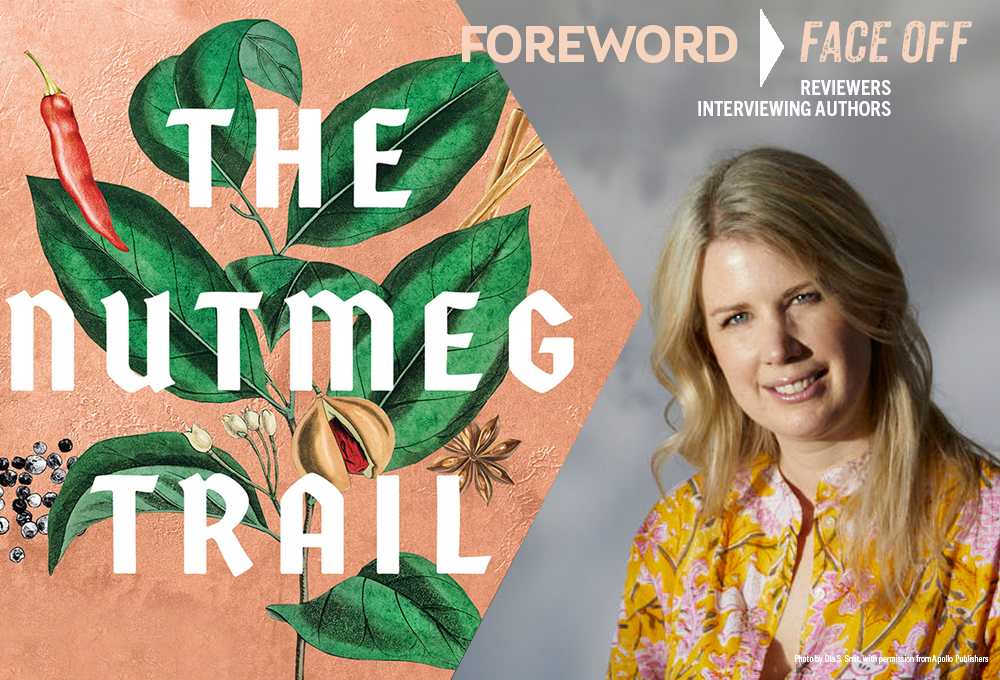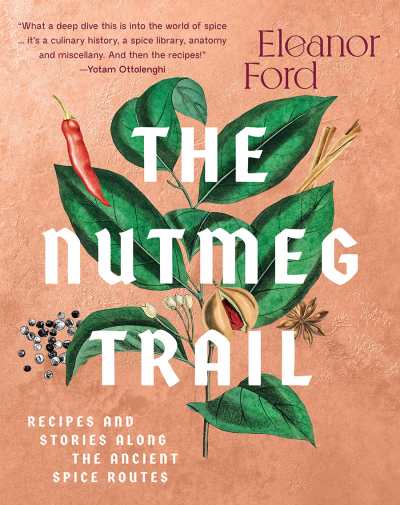Reviewer Meg Nola Interviews Eleanor Ford, Author of The Nutmeg Trail: Recipes and Stories Along the Ancient Spice Routes

One of the great surprises of research into prehistory is the effort put into improving the human condition. Misery abounded for sure—gruel, grog, and unrelenting hardship—but the poor sods always tried to bring some pleasure and comfort into their lives.
One of the ways we know this is by tracking the trade routes crisscrossing Europe and Asia. For thousands of years, all manner of specialty goods made their way into the hands of men and women striving for a little more culture—precious stones, silk, fur, tea, porcelain, spices, and more heading west from Asia—because once you develop a taste for cinnamon in your morning oats, there’s no going back.

In her conversation with Foreword‘s Meg Nola, this week’s guest, Eleanor Ford, offers us a delightful glimpse into that trade in cinnamon and dozens of other spices, all based on her research for The Nutmeg Trail, “a heady, informative trip through the realms of spices and time,” says Meg, alongside more than a few spice-laced recipes. Now that’s our kind of history book!
The Nutmeg Trail is filled with fascinating historical facts, like how Cleopatra used cardamom to seduce Marc Antony, and how peppercorns were once so valued that they were called “black gold.” Was there a particular inspiration for the cookbook, and how did the “unassuming” yet highly versatile nutmeg seed become the center of it all?
Spice’s history is full of magical encounters and extraordinary tales. With spice ubiquitous and easy to source today, it can be hard to imagine the power and value it once held. Nutmeg was desired so hotly that it perhaps holds the most astonishing story of them all…
There is an island so small and forgotten it is often left off today’s atlases altogether, but once Rhun was writ large on naval maps for this isle, and its neighbours in the Banda Sea of eastern Indonesia, was the only place on earth where nutmeg grew. This made it highly coveted and in 1667 the British and the Dutch exchanged two islands held under colonial rule on opposite sides of the earth: The Dutch got Rhun, fragrant isle of the nutmeg. In return the British got Manhattan and so New Amsterdam became New York.
With stories as powerful as these, and food just as exciting, I knew this was a book I had to write.
You reflect solemnly on the cumulative “suffering inflicted in the name of spice”—especially during the earlier centuries of the spice trade’s unchecked greed and colonial exploitation. How have global spice markets changed in recent years?
The Age of Discovery and rampaging colonial conquest from the fifteenth century onwards are crucial shapers of our modern world. The saga is eventually one of greed, monopolies, empire, and colonisation. After all, fortunes were made, blood spilt, maps redrawn, and the New World discovered all because of a desire for spice.
Yet we should remember that the peaceful trade and the gentle spread of ideas and knowledge that took place over many millennia prior make a quieter and equally important story of our world. The spice trade laid the pathway for globalization. Dating back four thousand years, sailors ploughed the Indian Ocean to transport spice and other early commodities. It brought peoples together and fueled the spread of science, religion, language, craftsmanship, expertise, and cookery.
If we turn to today, spice no longer holds the same mystery and value it once did, so the trade is quieter again. However, demand and supply are ever-growing. India is by far the greatest spice producer, yielding over 2.3 million tons each year. Even the remotest forest farmers can track prices at e-auctions on their mobiles.
While you were writing The Nutmeg Trail, you became part of the worldwide COVID shutdown. So in essence, you were researching the vast history of spices and spice voyages from the confines of your London home. Fortunately, you were able to keep in contact with others and access modern “trading routes” through the internet. Did the pandemic isolation help you to focus more intently on the project?
It was a strange time to be writing, just as it was a strange time to do anything! I feel that being grounded inevitably shaped the project for me and took me more into history. I was writing about a part of the world I have travelled through a lot in the past, but my research became academic rather than practical. It pushed me towards my role as in the book that has been described as a “culinary detective.”
You note how the pairing of turmeric and black pepper can have anti-inflammatory and antioxidant effects. Recent studies have also shown that cinnamon can help to control blood sugar levels, while ginger can alleviate nausea and boost immunity. What do you think of the renewed interest in these and other ancient “spice medicines?”
Scientific discovery has been proving some of the health benefits of spices long supposed by our ancestors, which is exciting. However, I think one should be circumspect of thinking of them as medicines. Rather, I would remember what spices are—the parts of plants most richly dense in flavour—and use them in them in cooking happy in the knowledge that they are a natural, healthy addition that can enliven and elevate food.
The Nutmeg Trail’s Venetian Chicken is a wonderful, savory-sweet combination of chicken, spices, dates, almond milk, and almond flakes, adapted from a handwritten recipe found in a 14th century Italian cookbook. How did you happen to find such an interesting volume?
The joy for me of writing this book is that it isn’t simply about the history and stories of spice, or the science, or the practicalities of cooking with it. It is a fusion of all of these. As such, my research took me far and wide, deep into library reserves and to a few ancient recipes as well to seek out flavour combinations that still hold charm today.
The Nutmeg Trail identifies various regional spice palettes, like the “hot, tart, fresh” intensity of Central/South India, with its “signature” spices of tamarind, chili, mustard, curry leaf, ginger, cumin, etc. Vietnamese cuisine is “fresh, delicate [and] vibrant,” with flavors of chili, ginger, lemongrass, cilantro, and star anise. Do you tend to favor certain spice palettes in your everyday cooking, or perhaps prefer others seasonally?
I am an endless experimenter in the kitchen and love variety. I guess the unifier I look for in my cooking, and in all the recipes I share, is simple food with big, bright flavours. I love food that can transport you somewhere from within your own kitchen.
Are you working on a new book—spicy or otherwise?
Yes! I can’t reveal too much about it yet, but I will say that my already immodest spice collection is still growing.
Check out our Petit Foreword videos with Margaret Renkl, André Alexis, Richard Dawkins, and many other talented writers conversing with our top editors, Michelle Anne Schingler and Danielle Ballantyne.
Meg Nola
